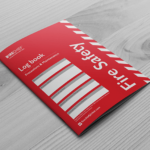
The Firechief Fire Safety Logbook enables business and premises owners to record and maintain fire safety procedures and equipment required by legislation. It is a simple and effective way of ensuring faults are highlighted, equipment is tested regularly, and actions are taken to maintain fire safety.
The logbook also communicates vital information to anyone who needs it and helps prove lawful compliance with regulations.
The fire safety logbook should record regular checks and findings on:
- All escape routes are being kept clear, and the floor in a good state
- All fire escapes can be opened easily
- Any faults in systems and equipment
- All fire alarm systems are working
- The emergency lighting is working
- Fire doors close correctly and are in good working order
- Fire exit signs are in the right place
- Training and fire drill log
Escape routes
All escape routes on the property must be properly maintained and kept free from any obstructions at all times. A regular inspection should be carried out to ensure the following:
- Doors that are on escape routes must be easily openable without the use of a key or special procedure
- All escape routes, including staircases, corridors etc are free from obstruction
- All self-closing devices should be effective in operation
- All walls, doors, floors, and glazing, which are required to stop the passage of fire and smoke should be inspected to ensure that the fire and smoke resistance is being maintenance. For example, look for holes in walls and floors, ensure there is no broken glazing, doors are not damaged and smoke seals touch the door and frame continuously.
Fire Fighting Equipment
- Routine inspection by user
- Regular inspection of all extinguishers should be carried out to ensure that they are in their appropriate position
- Annual inspection, service, and maintenance – this should be carried out by a competent person in accordance with the relevant part of the current standard
- Satisfactory annual tests should be recorded on a label on each extinguisher or alternatively in a register used solely for this purpose with each extinguisher having its on-identification number
Emergency Lighting
Regular servicing of emergency lighting systems is essential. The responsible person for the premises should carry out or appoint a competent person to carry out the inspections needed.
- The monthly function test can be carried out by a trained person as this simply involves switching on the lights for short period to ensure they illuminate and switching back off
- The annual discharge tests should be carried out by a competent and suitable qualified electrical engineer in accordance with the current standard for Emergency Lighting, BS 5266.
Fire Doors
Periodic checks should be carried out at least every 6 months, however, if there is a lot of traffic using the door this should then be more regularly.
The Firechief range includes high-performance fire extinguishers, fire blankets, first aid kits, lithium-ion fire extinguishers for your home and leisure time. For more information, call us on +44 (0)330 999 0019 or email sales@firechiefglobal.com.
The information contained within this blog is provided solely for general informational and educational purposes and is not intended as a substitute for professional advice. Before taking any actions based upon this information, we advise the reader to consult any and all relevant statutory or regulatory guidance and where felt necessary to consult a qualified fire or industry regulation professional. The use or reliance on any information contained herein is solely at the reader’s risk.

